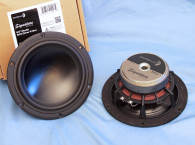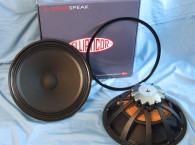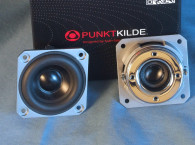
Cooling is provided by a 0.46” (18.6mm) diameter flared pole-type vent (Photo 2). Compliance is controlled by a 14mm wide NBR low-loss (high Qm) surround that has a very shallow transition to the cone, and a by a 3.25” diameter elevated cloth spider.

The motor assembly is powered by a FEA-optimized motor design utilizing a 90mm diameter 17mm thick Ferrite ring magnet sandwiched between the milled and polished 5mm thick front plate and T-yoke with a 5mm bump out. The motor assembly also incorporates both aluminum and copper shorting rings (Faraday shields) as portrayed in the Figure 1 drawing. Driving the cone assembly is a voice coil that consists of a 38mm (1.5”) diameter vented titanium former wound with round copper wire. Voice coil tinsel lead wires terminate to a pair of solderable gold-plated terminals.

Testing began with the driver clamped to a rigid test fixture in free-air and using the Physical LAB IMP Box (the same type of fixture as a LinearX VI Box) produced both voltage and admittance (current) curves at 0.3V, 1V, 3V, 6V, and 10V. The 10V curves were close to making a useful curve fit, however, were discarded. I post-processed the remaining eight 10Hz to 20kHz 550-point stepped sine wave curve pairs for each sample and divided the voltage curves by the current curves, creating the five impedance curves. The impedance curves each had the LMS phase calculation procedure applied, and along with the voltage curve for each sweep, all eight curves were imported to the LEAP 5 Enclosure Shop CAD software.
Since most Thiele-Small (T-S) data provided by OEM manufacturers is produced employing either a standard T-S model or the LinearX LEAP 4 TSL model, I additionally created a LEAP 4 TSL model using the 1V free-air curves. Please note, that even though LinearX is no longer in business after the unfortunate passing of its chief engineer and founder Chris Strahm seven years ago, LEAP 5 is still one of the best driver parameter generators ever devised, and I will continue to use it in Test Bench until I find some other software that is as accurate at predicting high voltage excursion as Chris Strahm’s multi-voltage LTD model.
I selected the complete curve set, the multiple voltage impedance curves derived from the LTD model and the 1V impedance curves for the TSL model in the transducer derivation menu in LEAP 5. Next, I created the parameters for the computer box simulations. Figure 2 shows the 1V free-air impedance curves. Table 1 compares the LEAP 5 LTD and TSL data and factory parameters for both Scan-Speak 15W/8534T00 samples.


T-S parameter results for the Scan-Speak Classic Series 5.5” midwoofer were nicely close to the factory data. That said, I followed my standard protocol and proceeded to program computer enclosure simulations using the LEAP LTD parameters for Sample 1. I used LEAP 5 Enclosure Shop to generate enclosure volumes estimated by the LEAP 5 Quick Design unit. The first is a 0.37ft3 Butterworth sealed box with 50% fiberglass fill material, plus an QB3-type vented alignment using 0.61ft3 box tuned to 36Hz and with 15% fiberglass fill material.
Figure 3 depicts the results for the 15W/8534T00 in the sealed and vented boxes at 2.83V and at a voltage level sufficiently high enough to increase cone excursion to Xmax+15% (5.75mm for the 15W). This enclosure simulation resulted in an F3 frequency of 61Hz (F6=48Hz) with a Qtc=0.69 for the 0.37ft3 sealed enclosure and –3dB=45Hz (F6=37Hz) for the 0.61ft3 vented QB3 box simulation. Increasing the voltage input to both simulations until the maximum linear cone excursion was reached resulted in 102dB at 15V for the smaller sealed enclosure and 103.5dB at 15V input level for the larger vented box. Figure 4 shows the 2.83V group delay curves. Figure 5 shows the 15V excursion curves.



Klippel analysis for the Scan-Speak 15W/8534T00 produced the Bl(X), Kms(X), and Bl and Kms symmetry range plots given in Figures 6-9. The Klippel data this month was performed by Patrick Turnmire at Redrock Acoustics using the Klippel DA2 analyzer (courtesy of Klippel GmbH). Please note, if you do not own a Klippel analyzer and would like to generate this type of data on any transducer, Redrock Acoustics is available to perform this and a myriad of other measurement and design consulting services.
The Bl(X) curve for the Scan-Speak 15W/8534T00 5.5” woofer (Figure 6) is moderately broad and symmetrical as you would expect for a moderate Xmax (5.0mm) 5.5” driver. Looking at the Bl symmetry plot (Figure 7), this curve is offset to a rather small 0.37mm coil-in (coil rearward) at the position of reasonable certainly (3mm) and mutating to 0.58mm coil-in offset at the 5mm physical Xmax of the driver.


Figure 8 and Figure 9 give the Kms(X) and Kms symmetry range curves for the 5.5” midbass transducer. The Kms(X) curve (Figure 8) is fairly symmetrical, and with a relatively small amount of coil-out (forward) offset. Looking at the Kms symmetry range curve (Figure 9), there is 1.1mm coil-out offset at the 1mm point (high certainty) and decreases to 0.73mm at the physical Xmax of the driver. Displacement limiting numbers calculated by the Klippel analyzer for the Scan-Speak 15W/8534T00 was XBl @ 82% Bl=4.9mm (pretty much the physical Xmax of the 15W) and for XC @ 75%, Cms minimum was 2.4mm, which means that for the Scan-Speak 15W/8534T00, the compliance was the most limiting factor at the prescribed distortion level of 10%. Using the less conservative 20% criteria, XBl @ 70% is Bl=5.9mm and XC @50% is 4.3mm.


Figure 10 gives the inductance curve L(X) for the Scan-Speak 15W/8534T00 5.5” midwoofer. Inductance will typically increase in the rear direction from the zero-rest position as the voice coil covers more pole area, which is what you see in the inductance graph. However, the inductance swing is only 0.057mH from Xmax in to Xmax out, which is Scan-Speak’s patented Symmetric Drive dual shorting ring system doing its job, providing very good inductive performance.

For the remaining series of SPL measurements, I mounted the Scan-Speak 15W/8534T00 in an enclosure with a 15”x7” baffle area and foam damped inside volume. Then, I measured the driver frequency response using the Loudsoft FINE R+D analyzer and the GRAS 46BE microphone (courtesy of Loudsoft and GRAS Sound & Vibration) both on- and off-axis from 300Hz to 20kHz with a 1/6 octave smoothing (to simulate the 100-point LMS resolution that I’ve used for years in this column) at 2V/0.5m (normalized to 2.83V/1m), using the cosine windowed FFT method. Figure 11 depicts the Scan-Speak 15W on-axis response, yielding a very smooth rising response from about 200Hz to 4kHz that when contoured flat should yield a ±2dB response. This is followed by a 5.5dB peak just prior to the transition to the transducer’s second-order asymptotic slope.

Figure 12 illustrates the on- and off-axis frequency response at 0°, 15°, 30°, and 45°. The -3dB at 30° with respect to the on-axis curve occurs at 2.8kHz, which suggests a likely crossover point of 2.0kHz to 2.8kHz would be appropriate for the Scan-Speak 15W. Figure 13 gives the normalized version of Figure 12. Figure 14 shows the CLIO Pocket-generated horizontal plane polar plot (in 10° increments with 1/3 octave smoothing applied), with the CLIO Pocket provided courtesy of Audiomatica SRL. And last, Figure 15 gives the two-sample SPL comparisons for the Scan-Speak Classic Series 5.5” driver, showing both samples very closely matched ≤0.5dB throughout the operating range of the driver.




Next, I fired up the Listen SoundCheck analyzer using Soundcheck 21 software and the AudioConnect interface along with the ¼” SCM measurement microphone (provided courtesy of Listen, Inc.). I set them up for distortion measurements with the SPL at 1m for the 15cm Scan-Speak woofer mounted in free-air, using a noise stimulus set to 94dB (7.16V) at 1m, my standard for home audio devices. The Scan-Speak 15W/8534T00 produced the distortion curves shown in Figure 16.

Next, I mounted the driver in the same enclosure baffle used for the frequency response measurements and performed the time-domain measurements. This was imported into Listen’s SoundMap software, windowed to remove the room reflections. Figure 17 shows the cumulative spectral decay (CSD) waterfall plot. Figure 18 shows the Wigner-Ville plot.


Given the application of the new Phenomax cone along with all the measured data, Scan-Speak’s new 15W/8534T00 looks like a nice addition to the company’s Classic line of transducers. For more information, visit www.scan-speak.dk. VC
This article was originally published in Voice Coil, July 2024







